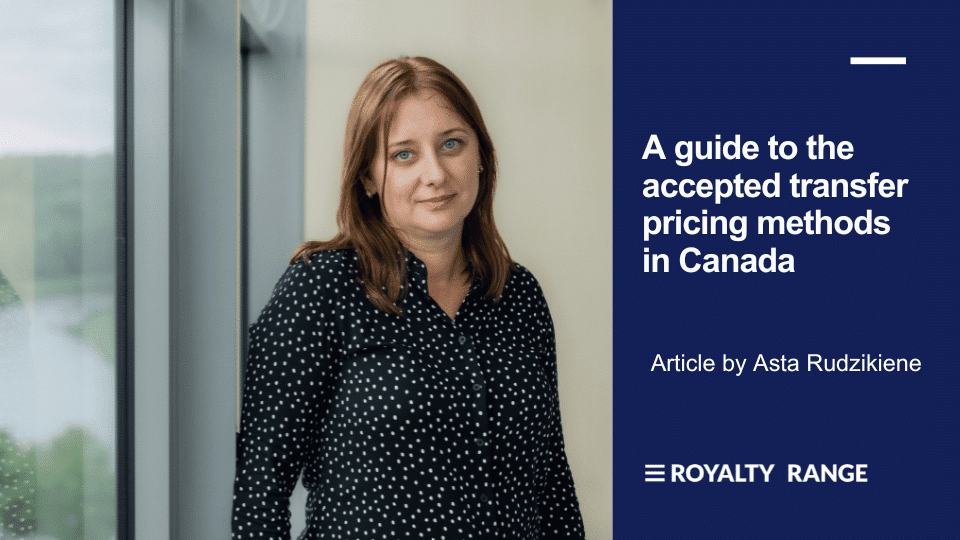A guide to the accepted transfer pricing methods in Canada

Asta Rudzikiene |
December 15, 2023

Along with all G7 countries, Canada is committed to ensuring that transfer pricing is carried out accurately and that it will not result in the erosion of its tax base.
The Canadian government and tax authorities actively monitor multinational enterprises’ reporting of their taxable activity in the nation’s jurisdictions. Multinational enterprises must adhere to guidelines and legislation that govern how the methods for calculating transfer pricing are applied – or they risk becoming embroiled in challenges and disputes.
Canada’s rules for transfer pricing
Canada remains closely aligned with the Organisation for Economic Co-operation and Development’s (OECD) Transfer Pricing Guidelines for Multinational Enterprises and Tax Administrations. Its statutes are based on the principles of ‘arm’s length’ to determine when transfer pricing methods need to be used.
This principle outlines that the price of a controlled transaction—one made internally between related companies—must be set at a similar price to an uncontrolled transaction made with a third party.
Section 247 of the Canadian Income Tax Act (ITA) is the primary legislation that defines these arm’s length principles and sets out Canada’s rules for transfer pricing.
In addition, the Canadian Revenue Authority (CRA) periodically issues supplements to the legislation that update and clarify transfer pricing policy. Although these are non-binding, and Canadian Courts base judgements on legislation rather than these memoranda, they do offer a very useful sense of current thinking and likely future direction.
Kris Rudzika, Managing Partner at RoyaltyRange, explains that “Canada is actively looking to maximise its tax base and tighten the regulation of transfer pricing. We all should keep a close eye on budget and legislative updates.”
Canada also has tax treaties with a number of other countries that can affect transfer pricing.
Canada’s approach to transfer pricing methods
Broadly speaking, Canada follows the OECD guidelines on how to use transfer pricing methods.
For example, the CRA’s Information Circular IC 87-2R (now cancelled) contained over 25 direct references to the OECD Transfer Pricing Guidelines, and in Paragraph 4 it stated that “OECD (Transfer) Guidelines should be consulted for a more detailed discussion of the principles contained in Parts 2 to 6 of this circular.”
The Canadian tax courts have also explicitly acknowledged the relevance of the OECD Transfer Pricing Guidelines in details of decisions made that relate to transfer pricing cases.
There are five main methods that are directly endorsed, although others may be acceptable. Depending on the circumstances and degree of comparability possible, the following methods may be used:
| Traditional transaction methods | Transactional profit methods |
| Comparable Uncontrolled Price (CUP) MethodResale Price MethodCost Plus Method | Transactional Net Margin Method (TNMM) / Comparable Profits Method (CPM)Profit split Method |
In TPM-14, the CRA confirmed that it will not attempt to apply a single, uniform method to all transfer pricing transactions. Instead, it wants to apply “the most appropriate transfer pricing method to the circumstances of the case”.
Nevertheless, the CRA does see a natural hierarchy among the transfer pricing methodologies. The CRA and the OECD guidelines both indicate that the traditional transaction methods, including the CUP method, are preferable to a transactional profit method. This is also a preference in recent court judgments, as this review by DRTP Consulting reveals.
Below, we review the five methods and outline instances where each should be considered.
Considerations when using the five transfer pricing methods
The five different methods are categorised as either traditional transaction methods or transactional profit methods.
Traditional transaction methods
1. Comparable Uncontrolled Price (CUP) Method
This is the preferred method for both the OECD and the CRA. It uses data from extremely similar transactions to compare the price of products or services in a controlled transaction with those in an uncontrolled transaction between unrelated parties.
The drawback of this method hinges on the availability of sufficient data. In practice, it can be difficult to identify transactions that meet comparability requirements.
2. The Resale Price Method
This is based on the selling price of a product or service. This resale price is reduced with a gross margin that is determined by the gross margins from comparable transactions with similar but unrelated organizations.
After this, the costs associated with purchasing the product—such as customs duties—are deducted to arrive at an appropriate arm’s length price.
While data may be widely available for this method, problems can arise in needing to use data that shares consistent economic circumstances and accounting methods. The uniqueness of each transaction can make it a challenge to meet resale price method requirements.
3. The Cost Plus Method
This compares a company’s gross profits to the overall cost of sales. It starts by calculating the costs incurred in a controlled transaction between affiliated companies. It then adds a market-based markup to the total to account for an appropriate profit.
Companies using this method need to identify the markup costs in comparable transactions between unrelated organizations.
This method is very useful for assessing transfer prices for straightforward activities, such as the manufacturing of tangible goods.
The downside of this method can be a lack of availability of comparable data and accounting consistency.
Transactional profit methods
Rather than examining the terms and conditions of specific transactions, profit-based methods look at the net operating profits from controlled transactions and compare them to the profits that third-party companies make from similar transactions.
Again, finding the comparable data necessary for the analysis is the big challenge. Even the smallest variations in features can lead to differences in price.
4. Transactional Net Margin Method (TNMM) / Comparable Profits Method (CPM)
The Transactional Net Margin Method (TNMM), or the Comparable Profits Method (CPM) in the US, reviews the net profit of a controlled transaction between related companies and compares this to the net profits in comparable uncontrolled transactions.
The TNMM/CPM is relatively easy to implement because it only requires financial data. This method can be best suited to manufacturers with relatively straightforward transactions. More complicated transactions risk overlooking relevant information about the counterparty to the transaction.
Increasingly, it is seen as not a good match for complex business models, such as tech companies with intellectual property.
5. The Profit Split Method
When associated enterprises engage in transactions, these may be interconnected – as is the case where two companies operate under the same brand.
In cases like these, the profit split method allows related companies to agree to split the profits. To do this, a comparison is made for the profit split arrived at from similar transactions between third parties.
This method looks at the wider profit allocation, rather than solely on a transactional basis. It is of particular relevance when dealing with intangible assets, such as intellectual property, or in situations with multiple controlled transactions occurring simultaneously.
However, it is often seen as a last resort that is only applicable to highly integrated organizations equally contributing value and assuming risk. It carries a higher chance of being disputed by the tax authorities.
Summary of transfer pricing methods
| Method | Overview |
| CUP Method | ● The preferred method of both the CRA and OECD. ● Based on transactional price data so may not be appropriate for more complex scenarios. ● Requires market data based on comparable uncontrolled prices. |
| Resale Price Method | ● Based on comparing the gross margin of uncontrolled transactions. ● Requires data that shares comparable economic circumstances and uses the same accounting methods. The resale activities and associated functions must align with open market transactions. |
| Cost Plus Method | ● Based on comparing a company’s gross profits to the overall cost of sales in an uncontrolled market. ● Widely used for cost coverage scenarios with a reasonable profit margin and for assessing transfer prices for straightforward activities, such as the manufacturing of tangible goods. ● Requires comparable data and accounting consistency. May not be suited to more ‘intangible’ activities. |
| Transactional Net Margin Method (TNMM) / Comparable Profit Method | ● Based on comparing the net profit of a controlled transaction with uncontrolled transactions. ● More applicable for relatively straightforward transactions (such as manufacturing) but more complicated transactions may risk overlooking relevant information about the compared uncontrolled businesses. ● Requires only financial data on profit margins to make its comparisons. |
| Profit Split Method | ● Based on an equitable allocation of profits based on value creation that is compared to similar arrangements in the uncontrolled market. ● It is applicable when contributions to value creation cannot be reliably evaluated using other methods. ● As it looks at profit allocation in a holistic way, it can be useful when dealing with intangibles such as intellectual property, or in large, integrated organizations where multiple controlled transactions happen simultaneously. ● Runs the risk of being viewed as more ‘subjective’ and disputed by tax authorities. |
Data: at the heart of transfer pricing
While it is clear that there are definite preferences for certain methods within the Canadian legislation, CRA, and courts, it is also evident that, without highly accurate data, finding comparisons with the uncontrolled market for transfer pricing is impossible.
Above we have outlined the current state of play for transfer pricing in Canada and reviewed the potential drawbacks and applicability of each. But without access to data, no method will suffice.
“The determination of transfer pricing method and accuracy in results depends, above all else, on access to high-quality comparable data, which is exactly what our databases are there to provide,” says Kris Rudzika, Managing Partner at RoyaltyRange.
The information provided below is for general informational purposes only and should not be construed as legal or tax advice. It is not a substitute for consulting with a qualified legal or tax professional.
Request One Search
We will perform the search and deliver the initial results within hours, at no cost.




